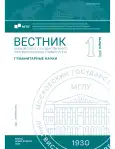Voice Quality as a Sociophonetic Variable in American and British Linguocultural Context
- Authors: Kartashevskaya Y.1
-
Affiliations:
- Moscow State Linguistic University
- Issue: No 1(895) (2025)
- Pages: 52-60
- Section: Linguistics
- URL: https://journal-vniispk.ru/2542-2197/article/view/279187
- ID: 279187
Cite item
Full Text
Abstract
The paper presents the experimental data on non-modal (creaky) phonation viewed as a marker of social variation in English. The objective of the research is to analyse sociophonetic functions of creaky phonation and to collect data on the perceptual and acoustic features of this type of nonmodal phonation. The research is based on voice samples of young British and American female speakers (n=6). Methods used in the research are: perceptual, acoustic and comparative analyses. Fundamental frequency (F0), jitter, shimmer and harmonics-to-noise ratio data revealed creaky phonation correlates at the acoustic level. The results demonstrate the highest frequency of creaky phonation occurrence in American female speech.
About the authors
Yulia Kartashevskaya
Moscow State Linguistic University
Author for correspondence.
Email: juliakar@mail.ru
SPIN-code: 5830-0666
Russian Federation
References
- Dallaston, K., Docherty, G. (2020). The quantitative prevalence of creaky voice (vocal fry) in varieties of English: A systematic review of the literature. PLoSOne, 15(3):e0229960. 10.1371/journal.pone.0229960.
- Kartashevskaya, Y. V. (2020). Phonopragmatic conditioning of voice quality modification in English discourse. Vestnik of Moscow State Linguistic University. Humanities, 1(830), 101–112. (in Russ.)
- Esling, J. (1978). The identification of features of voice quality in social groups. Journal of the International Phonetic Association, 8, 18–23.
- Stuart-Smith, J. (1999) Voice quality in Glaswegian. Proceedings of the International Congress of Phonetic Sciences, 14, 2553–2556.
- Henton, C., Bladon, A. (1988). Creak as a sociophonetic marker. In Hyman, L., Li, Ch. N. (Eds.), Language, Speech, and Mind (pp. 3–29). London: Routledge.
- Sicoli, M. A. (2015). Voice Registers. In Tannen, D., Hamilton, H. E., Schiffrin, D. (Eds.), The Handbook of Discourse Analysis (vol. I, pp. 105–126). Second Edition. John Wiley & Sons.
- Yuasa, I. P. (2010). Creaky voice: A new feminine voice quality for young urban-oriented upwardly mobile American women? American Speech, 85, 315–337.
- Podesva, R. J. (2013). Gender and the social meaning of non-modal phonation types. In Cathcart, Ch., Chen I.H., Finley, G., Kang, Sh., Sandy, C. S., Stickles, E. (Eds.), Proceedings of the 37th Annual Meeting of the Berkeley Linguistics Society, 37(1), 427–448.
- Абдуллина, Р. Э. (2024). Tactics of pitch convergence in natural British English conversation. Vestnik of Moscow State Linguistic University. Humanities, 2(883), 9–15. (In Russ.)
- Demina, M. A., Kartashevskaya, Y. V. (2017). Gender-marked patterns of prosodic attunement in small talk. Vestnik of Moscow State Linguistic University. Humanities, 5(776), 9–31. (In Russ.)
- Shevchenko, T., Gorbyleva, A. (2020). Temporal concord in speech interaction: overlaps and interruptions in spoken American English. Speech and Computer. SPECOM 2020 (pp. 490–499). Lecture Notes in Computer Science, 12335.
- Szczepek Reed, B. (2011). Analysing conversation: an introduction to prosody. Basingstoke: Palgrave Macmillan.
- Wright, R., Mansfield, C., Panfili, L. (2019). Voice quality types and uses in North American English. Anglophonia. French Journal of English Linguistics, 27. https://doi.org/10.4000/anglophonia.1952.
- Ogden, R. (2004). Non-modal voice quality and turn-taking in Finnish. In Couper-Kuhlen, E., Ford, C. E. (Eds.), Sound Patterns in Interaction (pp. 29–62). Amsterdam: Benjamins.
Supplementary files










